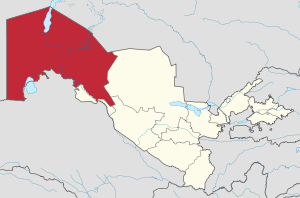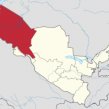
Moscow Set to Use Karakalpak Separatism Against a Pro-Western Tashkent
Publication: Eurasia Daily Monitor Volume: 11 Issue: 148
By:

The Russian government, which has used ethnic minority challenges against Moldova, Georgia, Azerbaijan and Ukraine to punish regimes whose foreign and domestic policies are at odds with Moscow’s now seems prepared to do the same thing in Uzbekistan. It appears Russia is attempting to exploit Karakalpak nationalism against the pro-Western policies of President Islam Karimov.
Karakalpakia is the poorest and most ecologically ravaged region in Uzbekistan. It has only 1.7 million people, compared to Uzbekistan’s 30 million, but its area—61,800 square miles—represents more than a third of the country’s total of 172,000 square miles. Moreover, Karakalpakia’s extensive oil and gas reserves make it a potentially serious challenger to the central government in Tashkent.
As Sergey Kozhemyakin points out in a July 31 issue of Moscow’s “Pravda” newspaper, Karakalpakia has seldom attracted much media attention in the past except in connection with the drying out of the adjoining Aral Sea and the disastrous health consequences that has had on the local population. But a few months ago, a number of Karakalpak activists announced that they were seeking independence from Tashkent (see EDM, June 13), a declaration that Uzbekistan’s central government denounced as “a provocation” organized by a foreign state (Pravda, July 31).
Uzbekistan did not name the foreign state involved. Yet, despite suggestions by some Moscow commentators to the contrary, the country involved almost certainly was Russia. Indeed, the “Forward Karakalpakia” movement declared on its Facebook page in March 2014 that the people of its republic “do not agree with the domestic and foreign policies of the regime of Islam Karimov” and that if the Kremlin gives “the signal, Karakalpakia is ready to raise the flag of the Russian Federation” (see EDM, June 13).
For his article in Pravda, Kozhemyakin spoke with Roman Mamytov, a Karakalpak activist who is living in Kyrgyzstan as “a political émigré.” Mamytov said that separatist attitudes are strong in Karakalpakia,” both because of and despite Uzbek oppression and Tashkent’s unwillingness to allow their articulation or permit a referendum (Pravda, July 31).
The Pravda commentator said that “it is difficult to check on the truthfulness of this assertion,” but he added that “the roots of such attitudes can be uncovered in the relatively recent past.” Karakalpakia became part of the Uzbek Soviet Socialist Republic (SSR) only in 1936. Before that, it was part of Kazakhstan with whose titular nationality the Karakalpaks are far more closely related.
In 1990, during perestroika, the Karakalpak Autonomous Republic’s Supreme Soviet adopted a declaration of state sovereignty, and by doing so, Kozhemyakin says, it effectively “declared independence” not only from Uzbekistan but from the Soviet Union itself. However, the lack of unity among Karakalpak legislators and other officials meant that it was unable to achieve much politically. Nonetheless, Tashkent was worried enough that, in 1993, it signed a treaty—much like the one Chisinau has with Gagauzia (see EDM, July 22)—that recognized Karakalpakia as a sovereign republic within Uzbekistan with the right to secede on the basis of a referendum. The treaty had a 20-year term and thus ceased to be in force last year (Pravda, July 31).
Tashkent ignored the expiration of the treaty, just as it had ignored many of the treaty’s provisions that would have given real autonomy to Karakalpakia. That only added fuel to the fire of nationalism and separatism generated by high levels of unemployment, health problems, and a general worsening of living conditions there. On occasion, these attitudes led to protests, the most dramatic of which occurred in 2010, when Karakalpaks went out into the streets with anti-Uzbek slogans to protest Tashkent’s plans to close a local factory.
According to Kozhemyakin, the desire of the Karakalpak activists to unite with Russia is “of course, naïve.” Not only is the area not contiguous to the Russian Federation, few in Russia would want yet more Turkic and Muslim nationalities inside the borders of their country. Consequently, the Pravda commentator suggests, some other foreign power must be involved because of the enormous oil and gas reserves to be found in Karakalpakia. He points to Tashkent’s recent investigation of the foreign sources of income of non-governmental organizations (NGO) in the autonomous republic. And he concludes that, given the clash of interests of “a whole line of countries in Central Asia today, it is impossible to exclude the possibility” that Karakalpakia will become the next “hot spot” in the region.
But Kozhemyakin’s argument undermines itself. For one thing, he asserts that the Karakalpaks dislike Tashkent’s foreign policy, something Moscow opposes as well. Additionally, Kozhemakhin underscores the fact that the secessionist Karakalpaks would like to become part of the Russian Federation—something that no other country besides Russia could possibly want. Furthermore, he fails to explain why the United States, the European Union or China would have any interest in undermining the government of Islam Karimov in Tashkent by promoting Karakalpak separatism. All three—Washington, Brussels and Beijing—have good relations with Tashkent, which would be put in jeopardy by challenging the territorial integrity of Karimov’s country. Unlike any of them, however, Moscow has the motive, the opportunity and the means to do just that.




